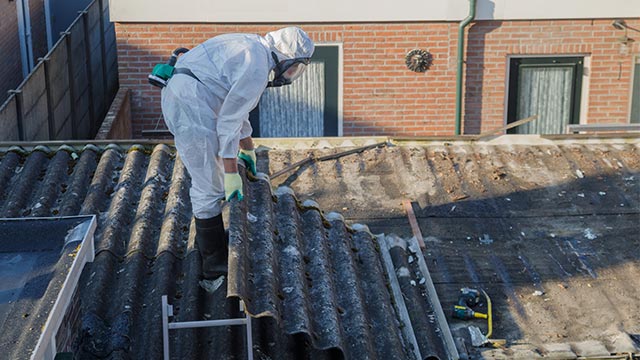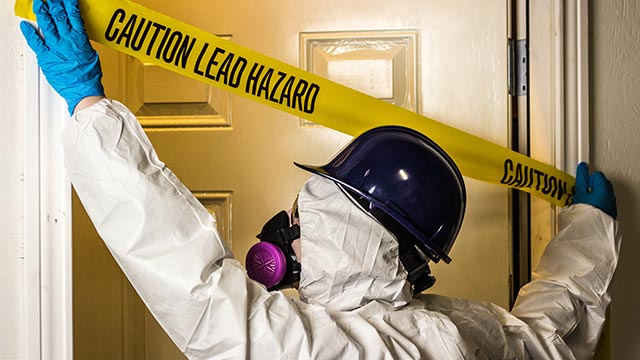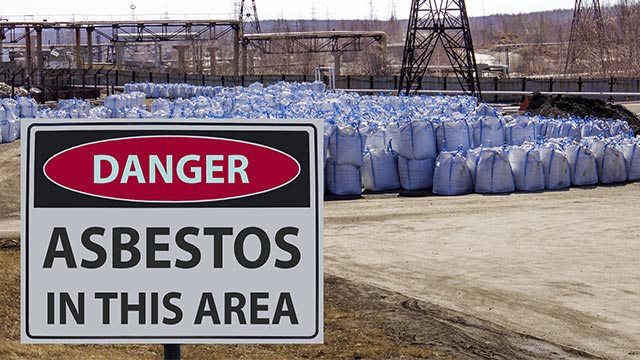What is Asbestos Removal?
Asbestos removal also called asbestos abatement, is the carefully controlled process of removing asbestos-containing materials (ACMs) from a building or structure. ACM is any material that contains more than one percent asbestos. It is linked to many diseases, like mesothelioma, asbestosis, and lung cancer.
Only licenced asbestos removal professionals are qualified to remove asbestos from homes and buildings, as it is a highly regulated process. This ensures that asbestos is removed safely and disposed of legally under the code of practice.
What is Asbestos?
Every year, around 4000 Australians die from asbestos-related diseases, making it one of the nation's leading causes of workplace death. Asbestos is a naturally occurring silicate mineral composed of long, thin, flexible fibres. It is heat resistant, durable, and does not rust easily.
Asbestos is commonly used in construction and manufacturing due to its resistant properties. Asbestos is an excellent insulator in everything from electrical wiring to home insulation.
While it is a valuable material, asbestos exposure can lead to serious health problems. As a result, many countries have regulated its use. When used correctly, asbestos can be a safe and effective material. However, it is vital to take precautions to avoid exposure to airborne fibres.
Types of asbestos
- Chrysotile (white asbestos) – the most common type of asbestos, usually found in the roofs, ceilings, walls, and floors of homes and businesses.
- Amosite (brown or grey asbestos) – commonly used in asbestos cement sheets and pipe insulation. You can find it in insulating boards, ceiling tiles, and thermal insulation products.
- Crocidolite (blue asbestos) – is one of the most hazardous types and is usually found in pipe insulation, spray-on coatings, and other plastic products.
- Tremolite and Actinolite – are two minerals that are chemically similar to each other. They can be found in various colours: brown, white, green, grey, and transparent.
- Anthophyllite – is used in insulation, fireproofing, and drywall products. It may appear grey, dull, or white.
Asbestos-Containing Materials (ACMs)
Asbestos-containing materials can harm health if not carefully maintained or removed. Inhaling asbestos fibres can result in several serious health issues, including lung cancer. There are two types of asbestos-containing materials: friable and non-friable.
Friable asbestos
Friable means it is easier to break apart, crumble or reduce to powder. This type of asbestos is more likely to become airborne. It poses a greater health risk because you can quickly inhale these fibres.
Non-friable asbestos
This asbestos is more difficult to break apart and is less of a health risk. It is usually found in asbestos-containing materials such as vinyl floor tiles, asbestos cement sheeting, and roof shingles.
Asbestos-Contaminated Dust or Debris (ACD)
While ACMs are often found in older buildings, ACD can occur anywhere that friable materials are present. Once disturbed, these materials can release asbestos fibres into the air, where workers or occupants of the space can inhale them.
If you find an ACD, you must take steps to contain and remove the material under local regulations. Only a licensed asbestos removalist should handle asbestos-contaminated dust or debris.
Uses and Where It Can Be found
Asbestos has been banned in 61 countries. Despite being banned in 2003 in Australia, it remains in many buildings, machinery parts, and products.
It is often hidden from view, making it difficult to remove. This poses a significant risk to public health, particularly for those who work in construction or demolition.
Asbestos in the home
If you built your house before 1990, it likely contains asbestos products. About one-third of all homes in Australia have ACMs somewhere in their construction. As long as asbestos products are not disturbed, they will not pose a health risk.
However, there is always a risk of asbestos exposure, significantly when ACMs are damaged or disturbed. The following places may contain ACMs:
- Roofs and eaves
- Walls and ceilings (such as ceiling plasters)
- Insulation (including asbestos insulation board)
- Floor tiles, carpets, and asbestos sheeting
- Pipe lagging
- Boilers and heaters
- Splashbacks
- Window putty
- Fireproofing

Asbestos in the workplace
Occupations most at risk of asbestos exposure include:
- Construction workers
- Demolition workers
- Asbestos removers
- Maintenance workers
- Shipyard workers
- Electricians
- Computer cabling installers
- Air-conditioning installers
- Plumbers
Asbestos was used in many products before 1990. It can be found in many buildings and structures built before then. Here are more areas where you can find asbestos:
Asbestos Insulation
Asbestos insulation was once a prevalent choice for both home and commercial buildings. It was known for its fireproofing qualities and ability to keep facilities warm in winter and cool in summer. Asbestos insulation is used for pipes, ducts, walls, and floors.
Heat-resistant items
Heat resistance made asbestos a popular choice for fireproofing materials, such as oven gloves and fire blankets. Asbestos was also used in hot water systems and boilers.
Automotive products
Asbestos was once used in automotive parts, such as brake pads and clutches. Cars and commercial vehicles also use it for insulation.
WHS laws prohibit people from working with asbestos because of its hazards, with some exceptions. In most cases, the law requires licensed workers to remove asbestos from work sites.
Asbestos Health Hazards
Inhalation is the primary way asbestos enters the body and can cause asbestos-related diseases. When someone breathes in asbestos fibres, they reach the lungs and become trapped in the alveoli. These fibres can remain in the lungs for years and can lead to cancers such as lung cancer, ovarian cancer, laryngeal cancer, and mesothelioma.
Anyone can be at risk of exposure to asbestos. Working or living in an old facility doesn't mean asbestos is present. Still, if ACMs are disturbed, asbestos fibres can be released into the air and pose a health risk. This is where safe asbestos removal comes in.
WHS Duties
The duty holders under WHS laws include:
1. Person conducting a business or undertaking (PCBU)
PCBU must protect workers and others from the risks of asbestos. This includes taking all reasonable steps to ensure that asbestos is removed from the workplace or, if possible, preventing or minimising asbestos exposure.
Under the model WHS Regulations, a PCBU must:
- Provide training to all workers
- Arrange safe asbestos removal
- Ensures that a licenced asbestos removalist removes asbestos
- Keep an asbestos register and asbestos management plan
- Obtain a licence to remove asbestos.
2. Officers
Directors of companies and other organisations have a legal duty to ensure that employees and others are safe in the workplace. This includes taking reasonable steps to prevent asbestos exposure.
3. Workers
Employees must take care of their health and safety, as well of other people. They must comply with any reasonable instruction or cooperate with any policy or procedure related to health and safety in the workplace.
Asbestos Removal Licence Requirements
WHS laws require that only trained and licensed removalists perform asbestos removal. You cannot perform asbestos removal on your own. You must have a licence to remove asbestos.
The removal of asbestos is strictly regulated in most jurisdictions. However, in some states or territories, you may remove asbestos without a licence in limited situations. These situations include:
- Removing non-friable asbestos 10 square metres or less in size
- Removing asbestos-contaminated dust and debris made during the removal of non-friable asbestos
- Removing minor contamination of asbestos.
There are three types of asbestos removal licences:
Class A
- Can remove all kinds of asbestos
- Can remove any amount of ACM or asbestos.
Class B
- Only able to remove non-friable asbestos
- Required for the removal of 10 square meters of non-friable asbestos or ACM.
Licensed asbestos assessor
- Can do air monitoring
- Can do inspections
- Can issue work clearances to class A licence work
- Can identify asbestos and conduct a risk assessment
- Can review an asbestos register.
Managing Asbestos in the Workplace
Handling asbestos is hazardous and can be life-threatening, and it's essential to manage asbestos in the workplace properly. The Model Code of Practice: How to safely remove asbestos recommends that you do the following:
1. Monitor the health of your workers
It is a requirement for all workers who may be exposed to asbestos to undergo health monitoring. This includes a medical examination and recording of exposure and examination results. The PCBU must inform all workers of these requirements before carrying out work that may expose them to asbestos.
Health monitoring can help identify asbestos-related diseases early so treatment can start as soon as possible. Use a health surveillance record to track your worker's asbestos exposure, medical examinations, and other health issues.
2. Provide asbestos awareness training
The PCBU ensures that workers receive proper training on asbestos removal. The training is about general knowledge about asbestos:
- Health effects
- Types, uses, and presence
- Location of the asbestos register
- Correct usage of personal protective equipment (PPE)
- Safe work procedures
- Purpose of the training and health monitoring.

When workers receive adequate training, they know what to expect when asbestos is present in the workplace, its risks, and whom to call. You can use an asbestos awareness SWMS to help workers understand the dangers of asbestos.
3. Obtain an asbestos register
An asbestos register includes information about asbestos locations, types, and conditions. The person with management or control of the workplace must ensure that the register is up to date, review it, and revise it if necessary.
4. Prepare a control plan
An asbestos removal control plan is a document that states what measures need to be taken to keep workers and other people from being exposed to asbestos during the removal process. These measures should focus on minimising any potential risks from exposure.
5. Placing signage, barricades, and other warnings
The asbestos removal contractor must ensure that appropriate signs, barricades, and warning notices are in place to warn of asbestos hazards. Warning signs include limiting access to asbestos-containing areas.
You may need signs and barricades to keep people from the area where asbestos removal is ongoing. For example, you could put up a fence and post signs. You could also use locking access doors, but only if it doesn't create an evacuation hazard.

6. Perform Decontamination
One of the most important pieces of safety equipment for asbestos removalists is the decontamination unit. These units provide a safe and effective way to remove asbestos fibers from clothing, skin, and tools. After completing asbestos removal work, licensed removalists should take the time to clean themselves and their equipment in a decontamination unit. By taking these precautions, they can help to prevent exposure to hazardous asbestos fibers.
7. Provide Personal Protective Equipment (PPE)
The management should provide PPE to all asbestos removalists and other workers in the area. This includes gloves, respiratory protective equipment (RPE), coveralls, protective eyewear, and air-line respirators. PPE is essential to asbestos removal to protect workers from inhalation and contact with asbestos fibres.
8. Conduct air monitoring
Air monitoring means taking air samples to help understand the levels of asbestos fibres in the air. You can do it in two ways:
- Collecting samples in the area where asbestos removal is done
- Collecting samples in the workers' breathing zones.
Complete Your Asbestos Safety Management Plan with SafetyDocs
We have specified the steps to manage safe asbestos removal in your workplace. It would be best if you had a guide to show you how to implement asbestos safety measures in your workplace. Get all the safety documentation you need for asbestos removal in SafetyDocs by SafetyCulture.
We are Australia's leading provider of safety documentation, including management plans, SWMS, SOPs, registers, and more. We offer customisable documents to help you mitigate asbestos risks in your workplace. We're here to help you create a safe asbestos removal process.
Check out these documents to help you start:
- Asbestos Removal Safe Work Method Statement
- Asbestos Management Plan
- Automotive Asbestos Removal Safe Operating Procedure
- Demolition Safe Work Method Statement
Start managing asbestos safety with our documents on your side. Get in touch with us today!
Available for instant download and supplied in fully editable MS Word format for use in your business.
Please note that the above information is provided as a comment only and should not be relied on as professional, legal or financial advice.
Share This Article
